A Report on Employee Wellbeing Strategies in Human Resource Management
VerifiedAdded on 2023/01/12
|11
|3786
|20
Report
AI Summary
This report provides a comprehensive overview of employee wellbeing within the context of Human Resource Management (HRM). It begins by defining employee wellbeing and its significance, emphasizing its impact on employee health, happiness, and organizational productivity. The report then explores the concept of 'duty of care' and its role in ensuring employee satisfaction and motivation. The core of the report focuses on case studies of Marks and Spencer and Tesco, detailing their respective approaches to employee wellbeing initiatives. Marks and Spencer's efforts encompass physical, environmental, psychological, and social wellbeing programs, including gym memberships, healthy eating options, and social gatherings. Tesco's initiatives are also examined, highlighting their contributions to creating a positive work environment. The report concludes by emphasizing the importance of employee wellbeing for organizational success and the various strategies companies can employ to foster a healthy and productive workforce.
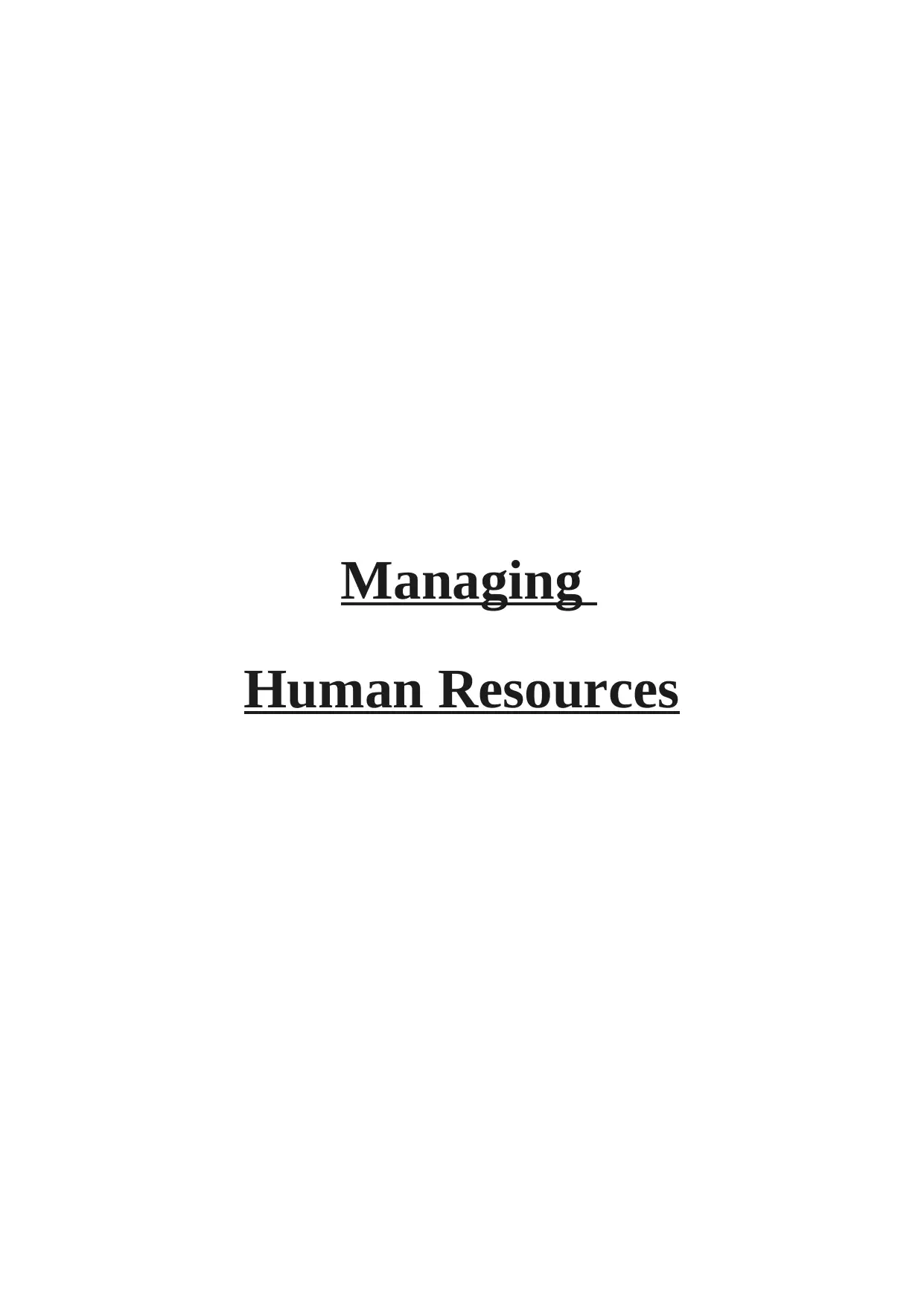
Managing
Human Resources
Human Resources
Paraphrase This Document
Need a fresh take? Get an instant paraphrase of this document with our AI Paraphraser

TABLE OF CONTENTS
INTRODUCTION...........................................................................................................................3
The concept of Employee well-being..........................................................................................3
Marks and Spencer’s Efforts at Employee Wellbeing.................................................................5
Tesco attempts Employee wellbeing initiatives...........................................................................7
CONCLUSION...................................................................................................................................10
REFERENCES....................................................................................................................................11
INTRODUCTION...........................................................................................................................3
The concept of Employee well-being..........................................................................................3
Marks and Spencer’s Efforts at Employee Wellbeing.................................................................5
Tesco attempts Employee wellbeing initiatives...........................................................................7
CONCLUSION...................................................................................................................................10
REFERENCES....................................................................................................................................11
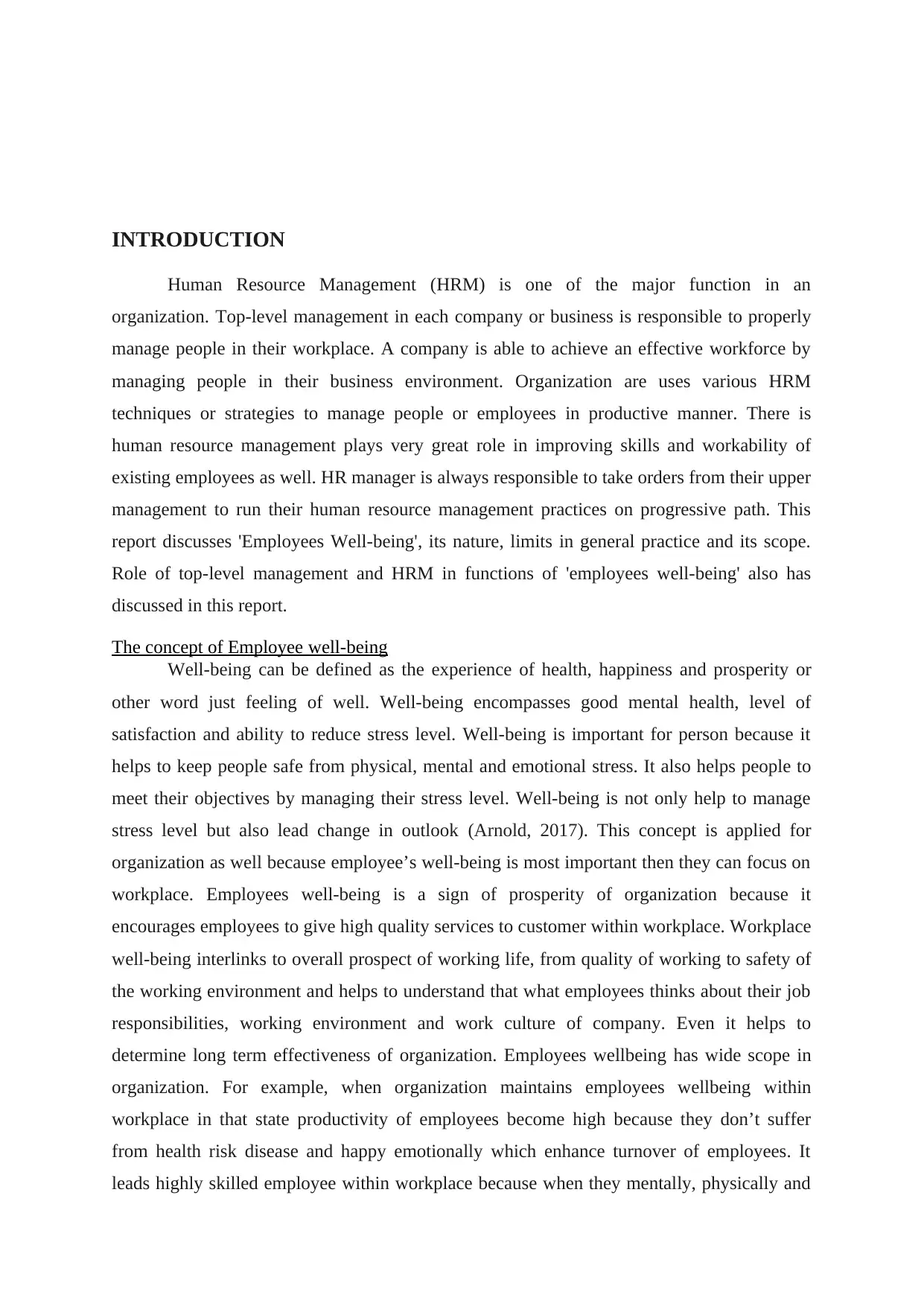
INTRODUCTION
Human Resource Management (HRM) is one of the major function in an
organization. Top-level management in each company or business is responsible to properly
manage people in their workplace. A company is able to achieve an effective workforce by
managing people in their business environment. Organization are uses various HRM
techniques or strategies to manage people or employees in productive manner. There is
human resource management plays very great role in improving skills and workability of
existing employees as well. HR manager is always responsible to take orders from their upper
management to run their human resource management practices on progressive path. This
report discusses 'Employees Well-being', its nature, limits in general practice and its scope.
Role of top-level management and HRM in functions of 'employees well-being' also has
discussed in this report.
The concept of Employee well-being
Well-being can be defined as the experience of health, happiness and prosperity or
other word just feeling of well. Well-being encompasses good mental health, level of
satisfaction and ability to reduce stress level. Well-being is important for person because it
helps to keep people safe from physical, mental and emotional stress. It also helps people to
meet their objectives by managing their stress level. Well-being is not only help to manage
stress level but also lead change in outlook (Arnold, 2017). This concept is applied for
organization as well because employee’s well-being is most important then they can focus on
workplace. Employees well-being is a sign of prosperity of organization because it
encourages employees to give high quality services to customer within workplace. Workplace
well-being interlinks to overall prospect of working life, from quality of working to safety of
the working environment and helps to understand that what employees thinks about their job
responsibilities, working environment and work culture of company. Even it helps to
determine long term effectiveness of organization. Employees wellbeing has wide scope in
organization. For example, when organization maintains employees wellbeing within
workplace in that state productivity of employees become high because they don’t suffer
from health risk disease and happy emotionally which enhance turnover of employees. It
leads highly skilled employee within workplace because when they mentally, physically and
Human Resource Management (HRM) is one of the major function in an
organization. Top-level management in each company or business is responsible to properly
manage people in their workplace. A company is able to achieve an effective workforce by
managing people in their business environment. Organization are uses various HRM
techniques or strategies to manage people or employees in productive manner. There is
human resource management plays very great role in improving skills and workability of
existing employees as well. HR manager is always responsible to take orders from their upper
management to run their human resource management practices on progressive path. This
report discusses 'Employees Well-being', its nature, limits in general practice and its scope.
Role of top-level management and HRM in functions of 'employees well-being' also has
discussed in this report.
The concept of Employee well-being
Well-being can be defined as the experience of health, happiness and prosperity or
other word just feeling of well. Well-being encompasses good mental health, level of
satisfaction and ability to reduce stress level. Well-being is important for person because it
helps to keep people safe from physical, mental and emotional stress. It also helps people to
meet their objectives by managing their stress level. Well-being is not only help to manage
stress level but also lead change in outlook (Arnold, 2017). This concept is applied for
organization as well because employee’s well-being is most important then they can focus on
workplace. Employees well-being is a sign of prosperity of organization because it
encourages employees to give high quality services to customer within workplace. Workplace
well-being interlinks to overall prospect of working life, from quality of working to safety of
the working environment and helps to understand that what employees thinks about their job
responsibilities, working environment and work culture of company. Even it helps to
determine long term effectiveness of organization. Employees wellbeing has wide scope in
organization. For example, when organization maintains employees wellbeing within
workplace in that state productivity of employees become high because they don’t suffer
from health risk disease and happy emotionally which enhance turnover of employees. It
leads highly skilled employee within workplace because when they mentally, physically and
⊘ This is a preview!⊘
Do you want full access?
Subscribe today to unlock all pages.

Trusted by 1+ million students worldwide
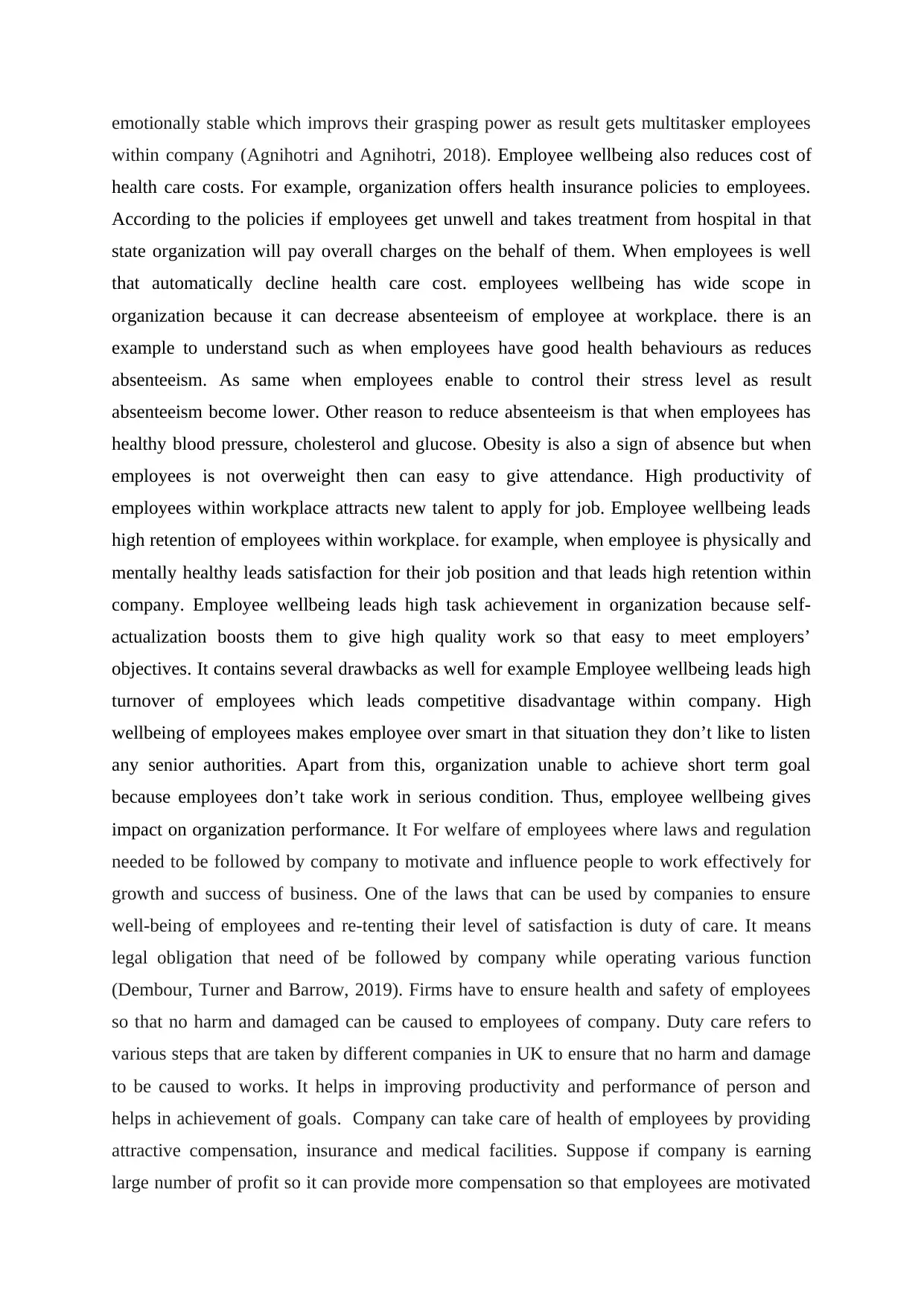
emotionally stable which improvs their grasping power as result gets multitasker employees
within company (Agnihotri and Agnihotri, 2018). Employee wellbeing also reduces cost of
health care costs. For example, organization offers health insurance policies to employees.
According to the policies if employees get unwell and takes treatment from hospital in that
state organization will pay overall charges on the behalf of them. When employees is well
that automatically decline health care cost. employees wellbeing has wide scope in
organization because it can decrease absenteeism of employee at workplace. there is an
example to understand such as when employees have good health behaviours as reduces
absenteeism. As same when employees enable to control their stress level as result
absenteeism become lower. Other reason to reduce absenteeism is that when employees has
healthy blood pressure, cholesterol and glucose. Obesity is also a sign of absence but when
employees is not overweight then can easy to give attendance. High productivity of
employees within workplace attracts new talent to apply for job. Employee wellbeing leads
high retention of employees within workplace. for example, when employee is physically and
mentally healthy leads satisfaction for their job position and that leads high retention within
company. Employee wellbeing leads high task achievement in organization because self-
actualization boosts them to give high quality work so that easy to meet employers’
objectives. It contains several drawbacks as well for example Employee wellbeing leads high
turnover of employees which leads competitive disadvantage within company. High
wellbeing of employees makes employee over smart in that situation they don’t like to listen
any senior authorities. Apart from this, organization unable to achieve short term goal
because employees don’t take work in serious condition. Thus, employee wellbeing gives
impact on organization performance. It For welfare of employees where laws and regulation
needed to be followed by company to motivate and influence people to work effectively for
growth and success of business. One of the laws that can be used by companies to ensure
well-being of employees and re-tenting their level of satisfaction is duty of care. It means
legal obligation that need of be followed by company while operating various function
(Dembour, Turner and Barrow, 2019). Firms have to ensure health and safety of employees
so that no harm and damaged can be caused to employees of company. Duty care refers to
various steps that are taken by different companies in UK to ensure that no harm and damage
to be caused to works. It helps in improving productivity and performance of person and
helps in achievement of goals. Company can take care of health of employees by providing
attractive compensation, insurance and medical facilities. Suppose if company is earning
large number of profit so it can provide more compensation so that employees are motivated
within company (Agnihotri and Agnihotri, 2018). Employee wellbeing also reduces cost of
health care costs. For example, organization offers health insurance policies to employees.
According to the policies if employees get unwell and takes treatment from hospital in that
state organization will pay overall charges on the behalf of them. When employees is well
that automatically decline health care cost. employees wellbeing has wide scope in
organization because it can decrease absenteeism of employee at workplace. there is an
example to understand such as when employees have good health behaviours as reduces
absenteeism. As same when employees enable to control their stress level as result
absenteeism become lower. Other reason to reduce absenteeism is that when employees has
healthy blood pressure, cholesterol and glucose. Obesity is also a sign of absence but when
employees is not overweight then can easy to give attendance. High productivity of
employees within workplace attracts new talent to apply for job. Employee wellbeing leads
high retention of employees within workplace. for example, when employee is physically and
mentally healthy leads satisfaction for their job position and that leads high retention within
company. Employee wellbeing leads high task achievement in organization because self-
actualization boosts them to give high quality work so that easy to meet employers’
objectives. It contains several drawbacks as well for example Employee wellbeing leads high
turnover of employees which leads competitive disadvantage within company. High
wellbeing of employees makes employee over smart in that situation they don’t like to listen
any senior authorities. Apart from this, organization unable to achieve short term goal
because employees don’t take work in serious condition. Thus, employee wellbeing gives
impact on organization performance. It For welfare of employees where laws and regulation
needed to be followed by company to motivate and influence people to work effectively for
growth and success of business. One of the laws that can be used by companies to ensure
well-being of employees and re-tenting their level of satisfaction is duty of care. It means
legal obligation that need of be followed by company while operating various function
(Dembour, Turner and Barrow, 2019). Firms have to ensure health and safety of employees
so that no harm and damaged can be caused to employees of company. Duty care refers to
various steps that are taken by different companies in UK to ensure that no harm and damage
to be caused to works. It helps in improving productivity and performance of person and
helps in achievement of goals. Company can take care of health of employees by providing
attractive compensation, insurance and medical facilities. Suppose if company is earning
large number of profit so it can provide more compensation so that employees are motivated
Paraphrase This Document
Need a fresh take? Get an instant paraphrase of this document with our AI Paraphraser
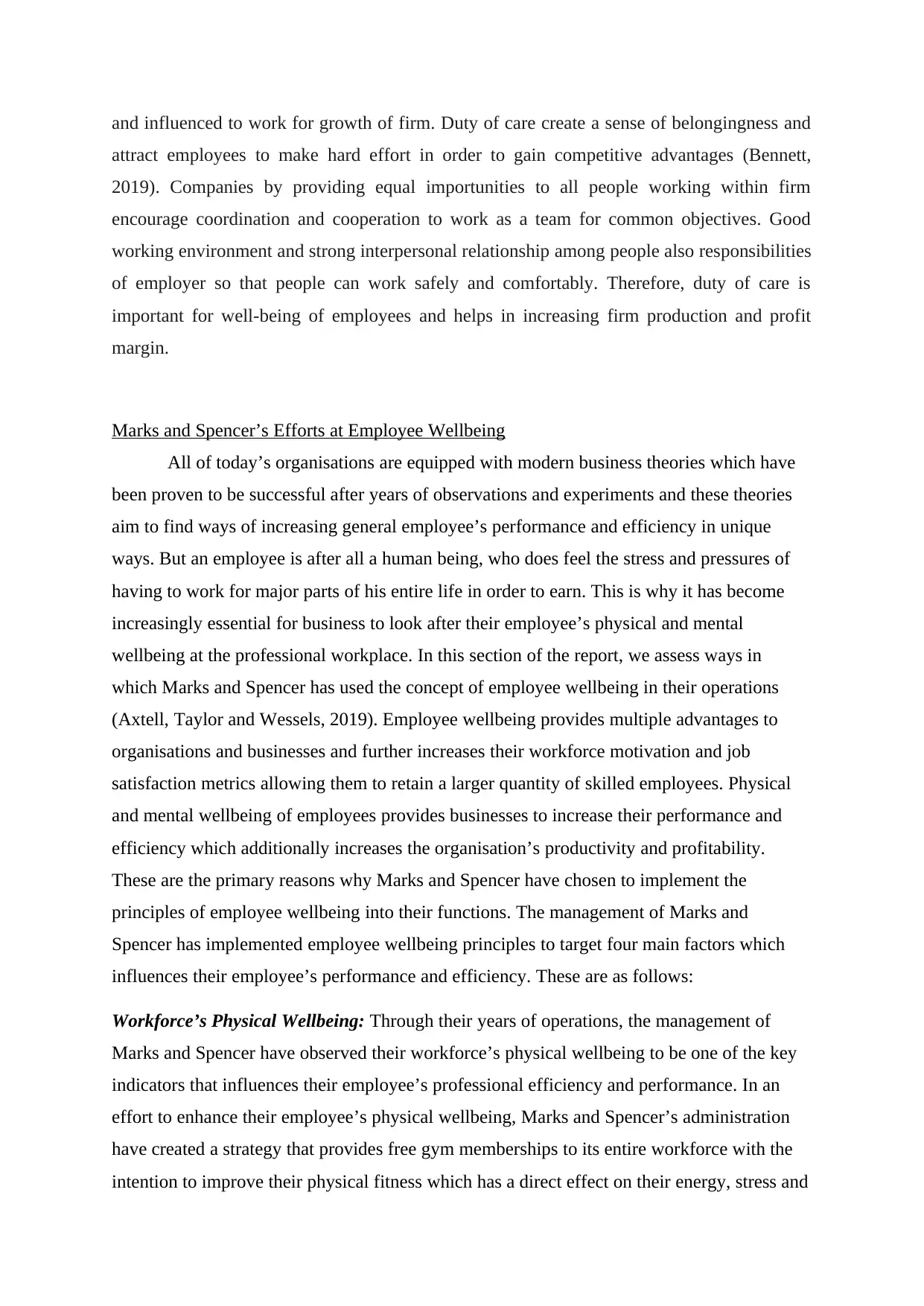
and influenced to work for growth of firm. Duty of care create a sense of belongingness and
attract employees to make hard effort in order to gain competitive advantages (Bennett,
2019). Companies by providing equal importunities to all people working within firm
encourage coordination and cooperation to work as a team for common objectives. Good
working environment and strong interpersonal relationship among people also responsibilities
of employer so that people can work safely and comfortably. Therefore, duty of care is
important for well-being of employees and helps in increasing firm production and profit
margin.
Marks and Spencer’s Efforts at Employee Wellbeing
All of today’s organisations are equipped with modern business theories which have
been proven to be successful after years of observations and experiments and these theories
aim to find ways of increasing general employee’s performance and efficiency in unique
ways. But an employee is after all a human being, who does feel the stress and pressures of
having to work for major parts of his entire life in order to earn. This is why it has become
increasingly essential for business to look after their employee’s physical and mental
wellbeing at the professional workplace. In this section of the report, we assess ways in
which Marks and Spencer has used the concept of employee wellbeing in their operations
(Axtell, Taylor and Wessels, 2019). Employee wellbeing provides multiple advantages to
organisations and businesses and further increases their workforce motivation and job
satisfaction metrics allowing them to retain a larger quantity of skilled employees. Physical
and mental wellbeing of employees provides businesses to increase their performance and
efficiency which additionally increases the organisation’s productivity and profitability.
These are the primary reasons why Marks and Spencer have chosen to implement the
principles of employee wellbeing into their functions. The management of Marks and
Spencer has implemented employee wellbeing principles to target four main factors which
influences their employee’s performance and efficiency. These are as follows:
Workforce’s Physical Wellbeing: Through their years of operations, the management of
Marks and Spencer have observed their workforce’s physical wellbeing to be one of the key
indicators that influences their employee’s professional efficiency and performance. In an
effort to enhance their employee’s physical wellbeing, Marks and Spencer’s administration
have created a strategy that provides free gym memberships to its entire workforce with the
intention to improve their physical fitness which has a direct effect on their energy, stress and
attract employees to make hard effort in order to gain competitive advantages (Bennett,
2019). Companies by providing equal importunities to all people working within firm
encourage coordination and cooperation to work as a team for common objectives. Good
working environment and strong interpersonal relationship among people also responsibilities
of employer so that people can work safely and comfortably. Therefore, duty of care is
important for well-being of employees and helps in increasing firm production and profit
margin.
Marks and Spencer’s Efforts at Employee Wellbeing
All of today’s organisations are equipped with modern business theories which have
been proven to be successful after years of observations and experiments and these theories
aim to find ways of increasing general employee’s performance and efficiency in unique
ways. But an employee is after all a human being, who does feel the stress and pressures of
having to work for major parts of his entire life in order to earn. This is why it has become
increasingly essential for business to look after their employee’s physical and mental
wellbeing at the professional workplace. In this section of the report, we assess ways in
which Marks and Spencer has used the concept of employee wellbeing in their operations
(Axtell, Taylor and Wessels, 2019). Employee wellbeing provides multiple advantages to
organisations and businesses and further increases their workforce motivation and job
satisfaction metrics allowing them to retain a larger quantity of skilled employees. Physical
and mental wellbeing of employees provides businesses to increase their performance and
efficiency which additionally increases the organisation’s productivity and profitability.
These are the primary reasons why Marks and Spencer have chosen to implement the
principles of employee wellbeing into their functions. The management of Marks and
Spencer has implemented employee wellbeing principles to target four main factors which
influences their employee’s performance and efficiency. These are as follows:
Workforce’s Physical Wellbeing: Through their years of operations, the management of
Marks and Spencer have observed their workforce’s physical wellbeing to be one of the key
indicators that influences their employee’s professional efficiency and performance. In an
effort to enhance their employee’s physical wellbeing, Marks and Spencer’s administration
have created a strategy that provides free gym memberships to its entire workforce with the
intention to improve their physical fitness which has a direct effect on their energy, stress and
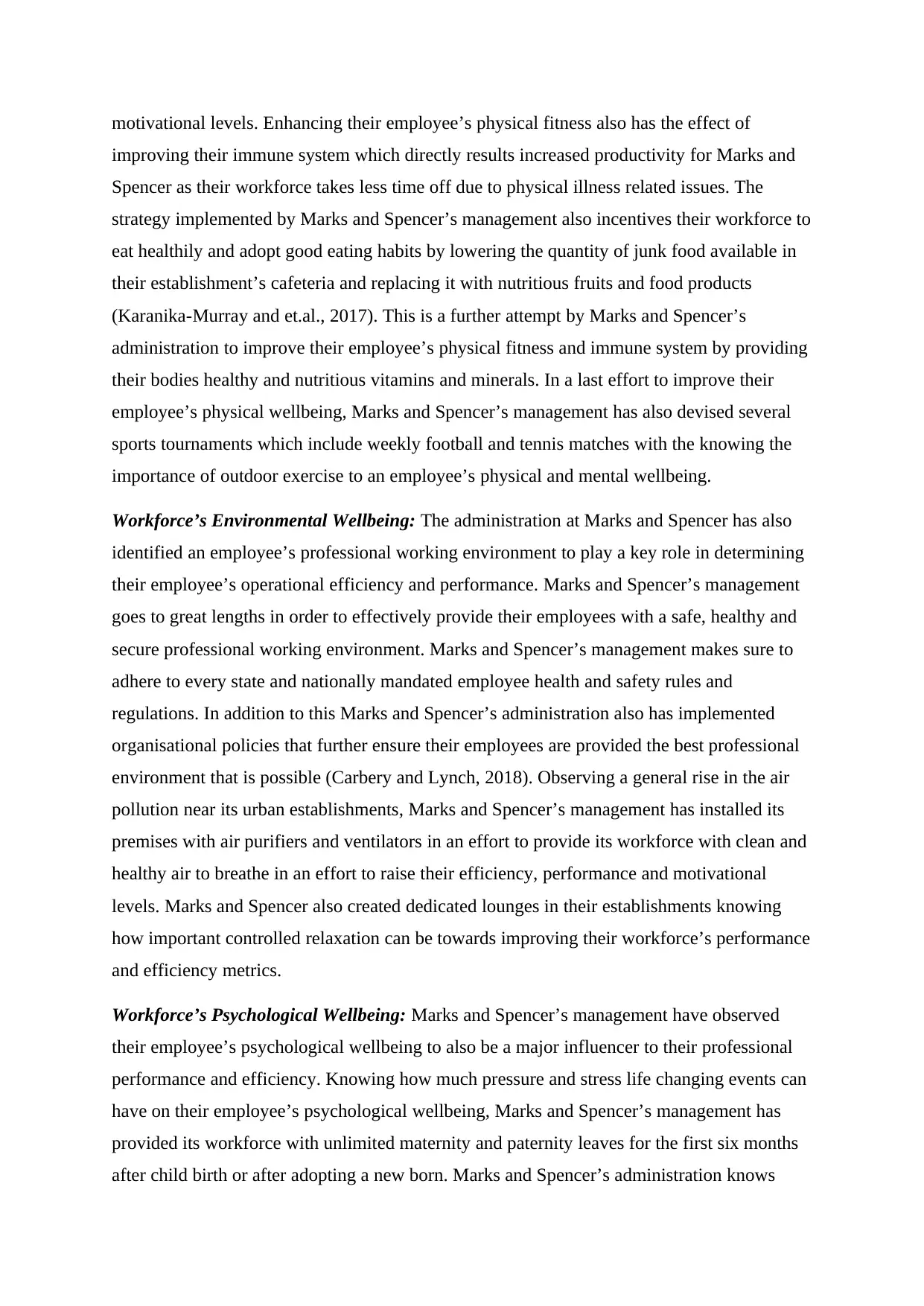
motivational levels. Enhancing their employee’s physical fitness also has the effect of
improving their immune system which directly results increased productivity for Marks and
Spencer as their workforce takes less time off due to physical illness related issues. The
strategy implemented by Marks and Spencer’s management also incentives their workforce to
eat healthily and adopt good eating habits by lowering the quantity of junk food available in
their establishment’s cafeteria and replacing it with nutritious fruits and food products
(Karanika-Murray and et.al., 2017). This is a further attempt by Marks and Spencer’s
administration to improve their employee’s physical fitness and immune system by providing
their bodies healthy and nutritious vitamins and minerals. In a last effort to improve their
employee’s physical wellbeing, Marks and Spencer’s management has also devised several
sports tournaments which include weekly football and tennis matches with the knowing the
importance of outdoor exercise to an employee’s physical and mental wellbeing.
Workforce’s Environmental Wellbeing: The administration at Marks and Spencer has also
identified an employee’s professional working environment to play a key role in determining
their employee’s operational efficiency and performance. Marks and Spencer’s management
goes to great lengths in order to effectively provide their employees with a safe, healthy and
secure professional working environment. Marks and Spencer’s management makes sure to
adhere to every state and nationally mandated employee health and safety rules and
regulations. In addition to this Marks and Spencer’s administration also has implemented
organisational policies that further ensure their employees are provided the best professional
environment that is possible (Carbery and Lynch, 2018). Observing a general rise in the air
pollution near its urban establishments, Marks and Spencer’s management has installed its
premises with air purifiers and ventilators in an effort to provide its workforce with clean and
healthy air to breathe in an effort to raise their efficiency, performance and motivational
levels. Marks and Spencer also created dedicated lounges in their establishments knowing
how important controlled relaxation can be towards improving their workforce’s performance
and efficiency metrics.
Workforce’s Psychological Wellbeing: Marks and Spencer’s management have observed
their employee’s psychological wellbeing to also be a major influencer to their professional
performance and efficiency. Knowing how much pressure and stress life changing events can
have on their employee’s psychological wellbeing, Marks and Spencer’s management has
provided its workforce with unlimited maternity and paternity leaves for the first six months
after child birth or after adopting a new born. Marks and Spencer’s administration knows
improving their immune system which directly results increased productivity for Marks and
Spencer as their workforce takes less time off due to physical illness related issues. The
strategy implemented by Marks and Spencer’s management also incentives their workforce to
eat healthily and adopt good eating habits by lowering the quantity of junk food available in
their establishment’s cafeteria and replacing it with nutritious fruits and food products
(Karanika-Murray and et.al., 2017). This is a further attempt by Marks and Spencer’s
administration to improve their employee’s physical fitness and immune system by providing
their bodies healthy and nutritious vitamins and minerals. In a last effort to improve their
employee’s physical wellbeing, Marks and Spencer’s management has also devised several
sports tournaments which include weekly football and tennis matches with the knowing the
importance of outdoor exercise to an employee’s physical and mental wellbeing.
Workforce’s Environmental Wellbeing: The administration at Marks and Spencer has also
identified an employee’s professional working environment to play a key role in determining
their employee’s operational efficiency and performance. Marks and Spencer’s management
goes to great lengths in order to effectively provide their employees with a safe, healthy and
secure professional working environment. Marks and Spencer’s management makes sure to
adhere to every state and nationally mandated employee health and safety rules and
regulations. In addition to this Marks and Spencer’s administration also has implemented
organisational policies that further ensure their employees are provided the best professional
environment that is possible (Carbery and Lynch, 2018). Observing a general rise in the air
pollution near its urban establishments, Marks and Spencer’s management has installed its
premises with air purifiers and ventilators in an effort to provide its workforce with clean and
healthy air to breathe in an effort to raise their efficiency, performance and motivational
levels. Marks and Spencer also created dedicated lounges in their establishments knowing
how important controlled relaxation can be towards improving their workforce’s performance
and efficiency metrics.
Workforce’s Psychological Wellbeing: Marks and Spencer’s management have observed
their employee’s psychological wellbeing to also be a major influencer to their professional
performance and efficiency. Knowing how much pressure and stress life changing events can
have on their employee’s psychological wellbeing, Marks and Spencer’s management has
provided its workforce with unlimited maternity and paternity leaves for the first six months
after child birth or after adopting a new born. Marks and Spencer’s administration knows
⊘ This is a preview!⊘
Do you want full access?
Subscribe today to unlock all pages.

Trusted by 1+ million students worldwide
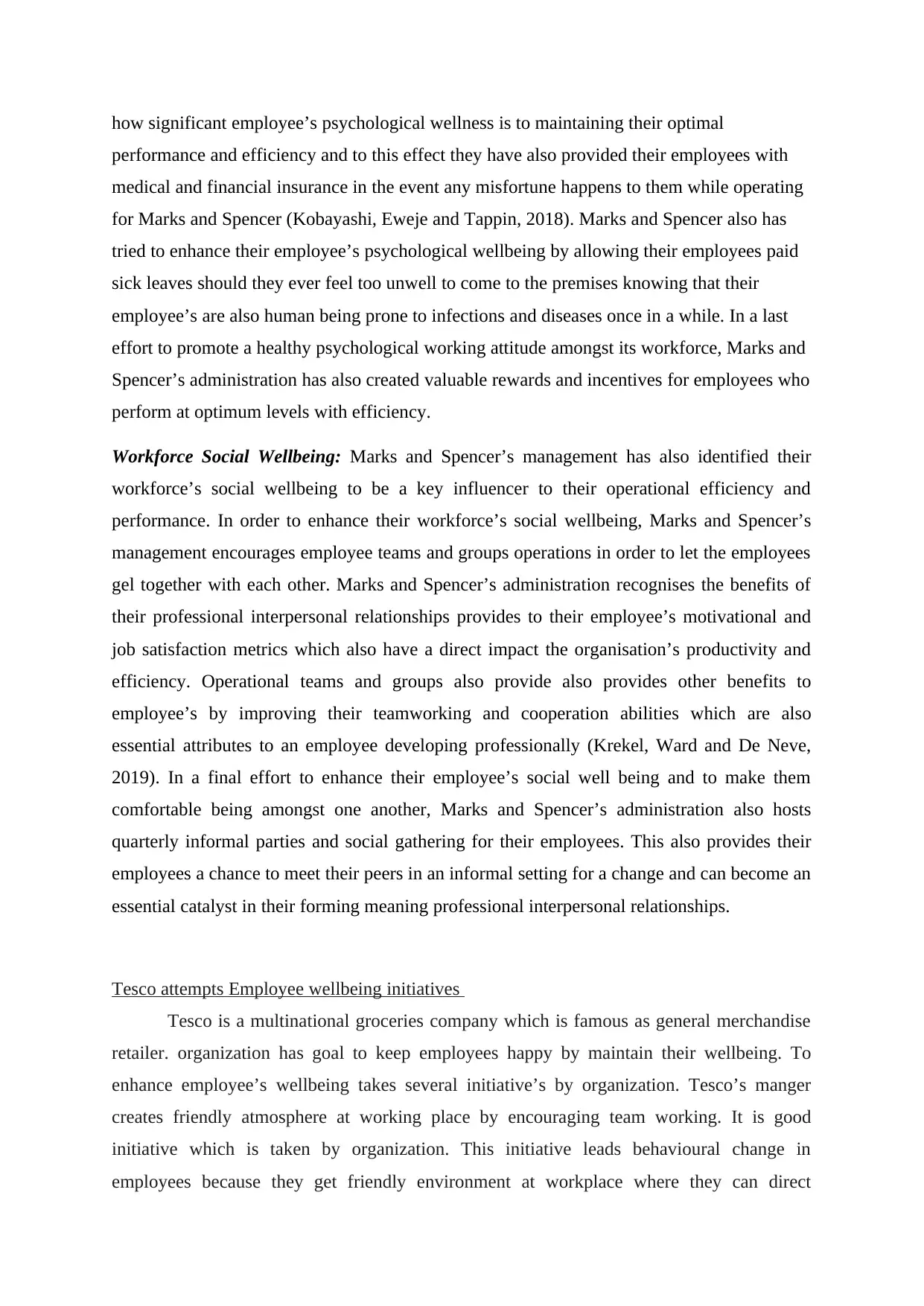
how significant employee’s psychological wellness is to maintaining their optimal
performance and efficiency and to this effect they have also provided their employees with
medical and financial insurance in the event any misfortune happens to them while operating
for Marks and Spencer (Kobayashi, Eweje and Tappin, 2018). Marks and Spencer also has
tried to enhance their employee’s psychological wellbeing by allowing their employees paid
sick leaves should they ever feel too unwell to come to the premises knowing that their
employee’s are also human being prone to infections and diseases once in a while. In a last
effort to promote a healthy psychological working attitude amongst its workforce, Marks and
Spencer’s administration has also created valuable rewards and incentives for employees who
perform at optimum levels with efficiency.
Workforce Social Wellbeing: Marks and Spencer’s management has also identified their
workforce’s social wellbeing to be a key influencer to their operational efficiency and
performance. In order to enhance their workforce’s social wellbeing, Marks and Spencer’s
management encourages employee teams and groups operations in order to let the employees
gel together with each other. Marks and Spencer’s administration recognises the benefits of
their professional interpersonal relationships provides to their employee’s motivational and
job satisfaction metrics which also have a direct impact the organisation’s productivity and
efficiency. Operational teams and groups also provide also provides other benefits to
employee’s by improving their teamworking and cooperation abilities which are also
essential attributes to an employee developing professionally (Krekel, Ward and De Neve,
2019). In a final effort to enhance their employee’s social well being and to make them
comfortable being amongst one another, Marks and Spencer’s administration also hosts
quarterly informal parties and social gathering for their employees. This also provides their
employees a chance to meet their peers in an informal setting for a change and can become an
essential catalyst in their forming meaning professional interpersonal relationships.
Tesco attempts Employee wellbeing initiatives
Tesco is a multinational groceries company which is famous as general merchandise
retailer. organization has goal to keep employees happy by maintain their wellbeing. To
enhance employee’s wellbeing takes several initiative’s by organization. Tesco’s manger
creates friendly atmosphere at working place by encouraging team working. It is good
initiative which is taken by organization. This initiative leads behavioural change in
employees because they get friendly environment at workplace where they can direct
performance and efficiency and to this effect they have also provided their employees with
medical and financial insurance in the event any misfortune happens to them while operating
for Marks and Spencer (Kobayashi, Eweje and Tappin, 2018). Marks and Spencer also has
tried to enhance their employee’s psychological wellbeing by allowing their employees paid
sick leaves should they ever feel too unwell to come to the premises knowing that their
employee’s are also human being prone to infections and diseases once in a while. In a last
effort to promote a healthy psychological working attitude amongst its workforce, Marks and
Spencer’s administration has also created valuable rewards and incentives for employees who
perform at optimum levels with efficiency.
Workforce Social Wellbeing: Marks and Spencer’s management has also identified their
workforce’s social wellbeing to be a key influencer to their operational efficiency and
performance. In order to enhance their workforce’s social wellbeing, Marks and Spencer’s
management encourages employee teams and groups operations in order to let the employees
gel together with each other. Marks and Spencer’s administration recognises the benefits of
their professional interpersonal relationships provides to their employee’s motivational and
job satisfaction metrics which also have a direct impact the organisation’s productivity and
efficiency. Operational teams and groups also provide also provides other benefits to
employee’s by improving their teamworking and cooperation abilities which are also
essential attributes to an employee developing professionally (Krekel, Ward and De Neve,
2019). In a final effort to enhance their employee’s social well being and to make them
comfortable being amongst one another, Marks and Spencer’s administration also hosts
quarterly informal parties and social gathering for their employees. This also provides their
employees a chance to meet their peers in an informal setting for a change and can become an
essential catalyst in their forming meaning professional interpersonal relationships.
Tesco attempts Employee wellbeing initiatives
Tesco is a multinational groceries company which is famous as general merchandise
retailer. organization has goal to keep employees happy by maintain their wellbeing. To
enhance employee’s wellbeing takes several initiative’s by organization. Tesco’s manger
creates friendly atmosphere at working place by encouraging team working. It is good
initiative which is taken by organization. This initiative leads behavioural change in
employees because they get friendly environment at workplace where they can direct
Paraphrase This Document
Need a fresh take? Get an instant paraphrase of this document with our AI Paraphraser
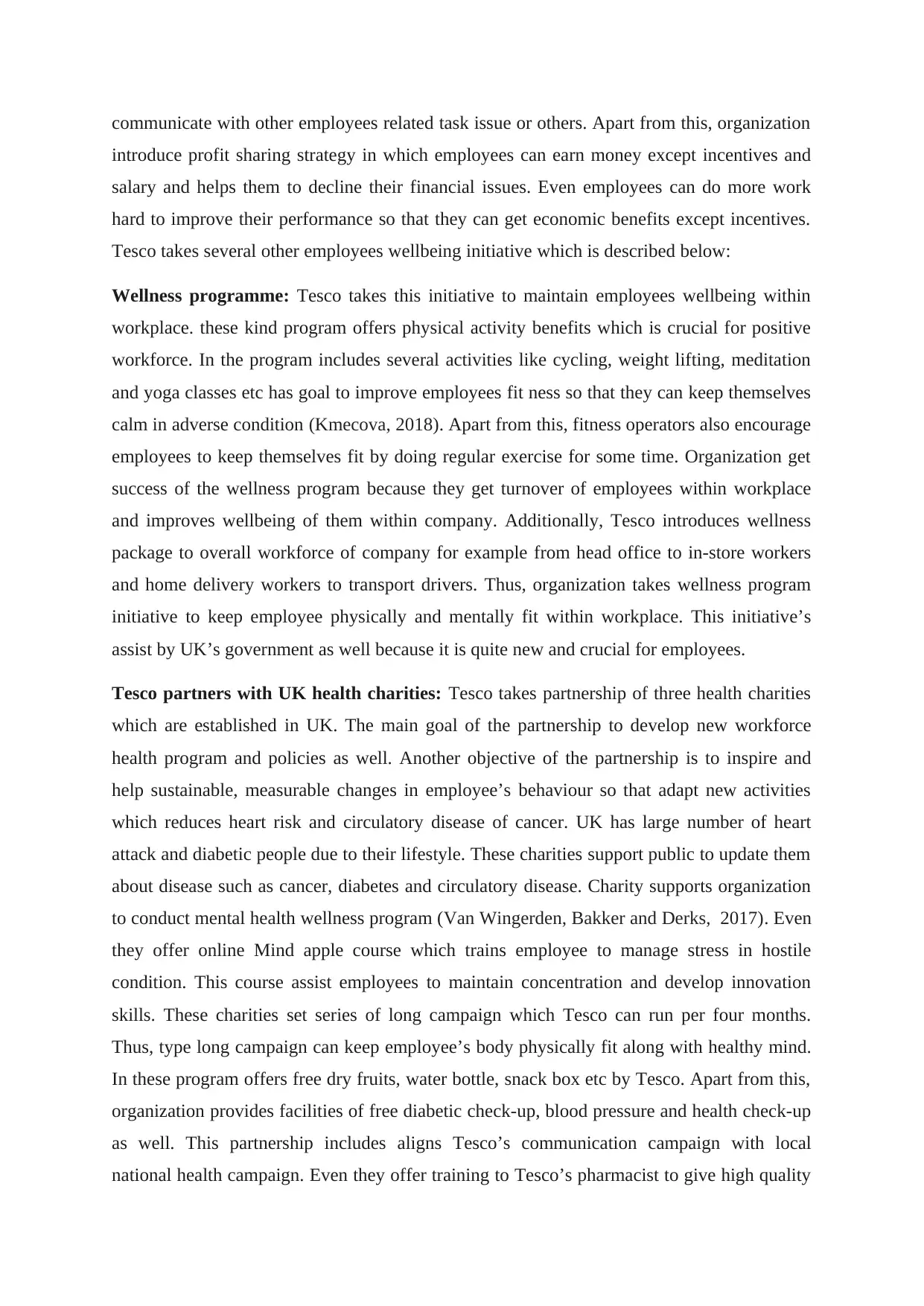
communicate with other employees related task issue or others. Apart from this, organization
introduce profit sharing strategy in which employees can earn money except incentives and
salary and helps them to decline their financial issues. Even employees can do more work
hard to improve their performance so that they can get economic benefits except incentives.
Tesco takes several other employees wellbeing initiative which is described below:
Wellness programme: Tesco takes this initiative to maintain employees wellbeing within
workplace. these kind program offers physical activity benefits which is crucial for positive
workforce. In the program includes several activities like cycling, weight lifting, meditation
and yoga classes etc has goal to improve employees fit ness so that they can keep themselves
calm in adverse condition (Kmecova, 2018). Apart from this, fitness operators also encourage
employees to keep themselves fit by doing regular exercise for some time. Organization get
success of the wellness program because they get turnover of employees within workplace
and improves wellbeing of them within company. Additionally, Tesco introduces wellness
package to overall workforce of company for example from head office to in-store workers
and home delivery workers to transport drivers. Thus, organization takes wellness program
initiative to keep employee physically and mentally fit within workplace. This initiative’s
assist by UK’s government as well because it is quite new and crucial for employees.
Tesco partners with UK health charities: Tesco takes partnership of three health charities
which are established in UK. The main goal of the partnership to develop new workforce
health program and policies as well. Another objective of the partnership is to inspire and
help sustainable, measurable changes in employee’s behaviour so that adapt new activities
which reduces heart risk and circulatory disease of cancer. UK has large number of heart
attack and diabetic people due to their lifestyle. These charities support public to update them
about disease such as cancer, diabetes and circulatory disease. Charity supports organization
to conduct mental health wellness program (Van Wingerden, Bakker and Derks, 2017). Even
they offer online Mind apple course which trains employee to manage stress in hostile
condition. This course assist employees to maintain concentration and develop innovation
skills. These charities set series of long campaign which Tesco can run per four months.
Thus, type long campaign can keep employee’s body physically fit along with healthy mind.
In these program offers free dry fruits, water bottle, snack box etc by Tesco. Apart from this,
organization provides facilities of free diabetic check-up, blood pressure and health check-up
as well. This partnership includes aligns Tesco’s communication campaign with local
national health campaign. Even they offer training to Tesco’s pharmacist to give high quality
introduce profit sharing strategy in which employees can earn money except incentives and
salary and helps them to decline their financial issues. Even employees can do more work
hard to improve their performance so that they can get economic benefits except incentives.
Tesco takes several other employees wellbeing initiative which is described below:
Wellness programme: Tesco takes this initiative to maintain employees wellbeing within
workplace. these kind program offers physical activity benefits which is crucial for positive
workforce. In the program includes several activities like cycling, weight lifting, meditation
and yoga classes etc has goal to improve employees fit ness so that they can keep themselves
calm in adverse condition (Kmecova, 2018). Apart from this, fitness operators also encourage
employees to keep themselves fit by doing regular exercise for some time. Organization get
success of the wellness program because they get turnover of employees within workplace
and improves wellbeing of them within company. Additionally, Tesco introduces wellness
package to overall workforce of company for example from head office to in-store workers
and home delivery workers to transport drivers. Thus, organization takes wellness program
initiative to keep employee physically and mentally fit within workplace. This initiative’s
assist by UK’s government as well because it is quite new and crucial for employees.
Tesco partners with UK health charities: Tesco takes partnership of three health charities
which are established in UK. The main goal of the partnership to develop new workforce
health program and policies as well. Another objective of the partnership is to inspire and
help sustainable, measurable changes in employee’s behaviour so that adapt new activities
which reduces heart risk and circulatory disease of cancer. UK has large number of heart
attack and diabetic people due to their lifestyle. These charities support public to update them
about disease such as cancer, diabetes and circulatory disease. Charity supports organization
to conduct mental health wellness program (Van Wingerden, Bakker and Derks, 2017). Even
they offer online Mind apple course which trains employee to manage stress in hostile
condition. This course assist employees to maintain concentration and develop innovation
skills. These charities set series of long campaign which Tesco can run per four months.
Thus, type long campaign can keep employee’s body physically fit along with healthy mind.
In these program offers free dry fruits, water bottle, snack box etc by Tesco. Apart from this,
organization provides facilities of free diabetic check-up, blood pressure and health check-up
as well. This partnership includes aligns Tesco’s communication campaign with local
national health campaign. Even they offer training to Tesco’s pharmacist to give high quality
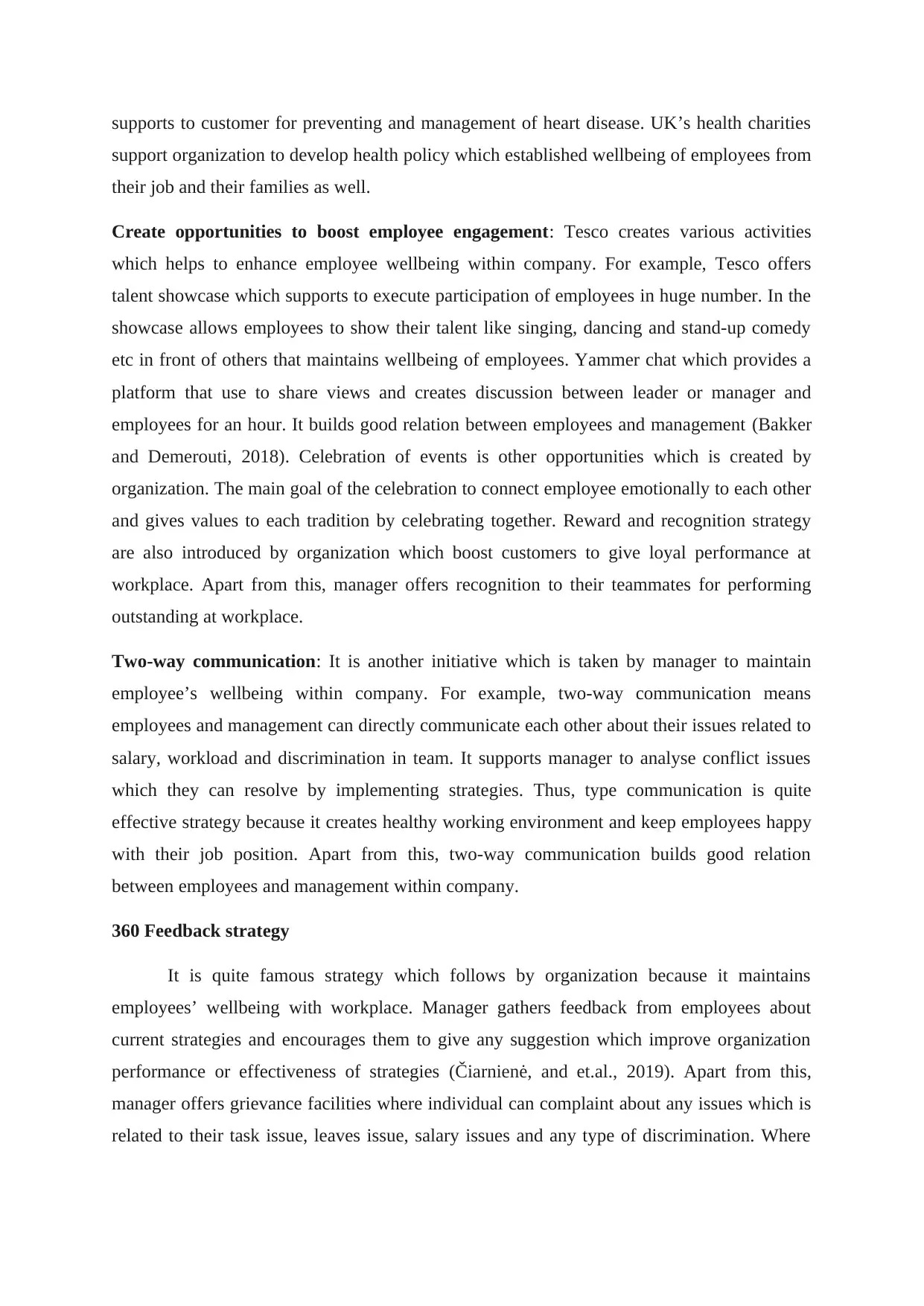
supports to customer for preventing and management of heart disease. UK’s health charities
support organization to develop health policy which established wellbeing of employees from
their job and their families as well.
Create opportunities to boost employee engagement: Tesco creates various activities
which helps to enhance employee wellbeing within company. For example, Tesco offers
talent showcase which supports to execute participation of employees in huge number. In the
showcase allows employees to show their talent like singing, dancing and stand-up comedy
etc in front of others that maintains wellbeing of employees. Yammer chat which provides a
platform that use to share views and creates discussion between leader or manager and
employees for an hour. It builds good relation between employees and management (Bakker
and Demerouti, 2018). Celebration of events is other opportunities which is created by
organization. The main goal of the celebration to connect employee emotionally to each other
and gives values to each tradition by celebrating together. Reward and recognition strategy
are also introduced by organization which boost customers to give loyal performance at
workplace. Apart from this, manager offers recognition to their teammates for performing
outstanding at workplace.
Two-way communication: It is another initiative which is taken by manager to maintain
employee’s wellbeing within company. For example, two-way communication means
employees and management can directly communicate each other about their issues related to
salary, workload and discrimination in team. It supports manager to analyse conflict issues
which they can resolve by implementing strategies. Thus, type communication is quite
effective strategy because it creates healthy working environment and keep employees happy
with their job position. Apart from this, two-way communication builds good relation
between employees and management within company.
360 Feedback strategy
It is quite famous strategy which follows by organization because it maintains
employees’ wellbeing with workplace. Manager gathers feedback from employees about
current strategies and encourages them to give any suggestion which improve organization
performance or effectiveness of strategies (Čiarnienė, and et.al., 2019). Apart from this,
manager offers grievance facilities where individual can complaint about any issues which is
related to their task issue, leaves issue, salary issues and any type of discrimination. Where
support organization to develop health policy which established wellbeing of employees from
their job and their families as well.
Create opportunities to boost employee engagement: Tesco creates various activities
which helps to enhance employee wellbeing within company. For example, Tesco offers
talent showcase which supports to execute participation of employees in huge number. In the
showcase allows employees to show their talent like singing, dancing and stand-up comedy
etc in front of others that maintains wellbeing of employees. Yammer chat which provides a
platform that use to share views and creates discussion between leader or manager and
employees for an hour. It builds good relation between employees and management (Bakker
and Demerouti, 2018). Celebration of events is other opportunities which is created by
organization. The main goal of the celebration to connect employee emotionally to each other
and gives values to each tradition by celebrating together. Reward and recognition strategy
are also introduced by organization which boost customers to give loyal performance at
workplace. Apart from this, manager offers recognition to their teammates for performing
outstanding at workplace.
Two-way communication: It is another initiative which is taken by manager to maintain
employee’s wellbeing within company. For example, two-way communication means
employees and management can directly communicate each other about their issues related to
salary, workload and discrimination in team. It supports manager to analyse conflict issues
which they can resolve by implementing strategies. Thus, type communication is quite
effective strategy because it creates healthy working environment and keep employees happy
with their job position. Apart from this, two-way communication builds good relation
between employees and management within company.
360 Feedback strategy
It is quite famous strategy which follows by organization because it maintains
employees’ wellbeing with workplace. Manager gathers feedback from employees about
current strategies and encourages them to give any suggestion which improve organization
performance or effectiveness of strategies (Čiarnienė, and et.al., 2019). Apart from this,
manager offers grievance facilities where individual can complaint about any issues which is
related to their task issue, leaves issue, salary issues and any type of discrimination. Where
⊘ This is a preview!⊘
Do you want full access?
Subscribe today to unlock all pages.

Trusted by 1+ million students worldwide
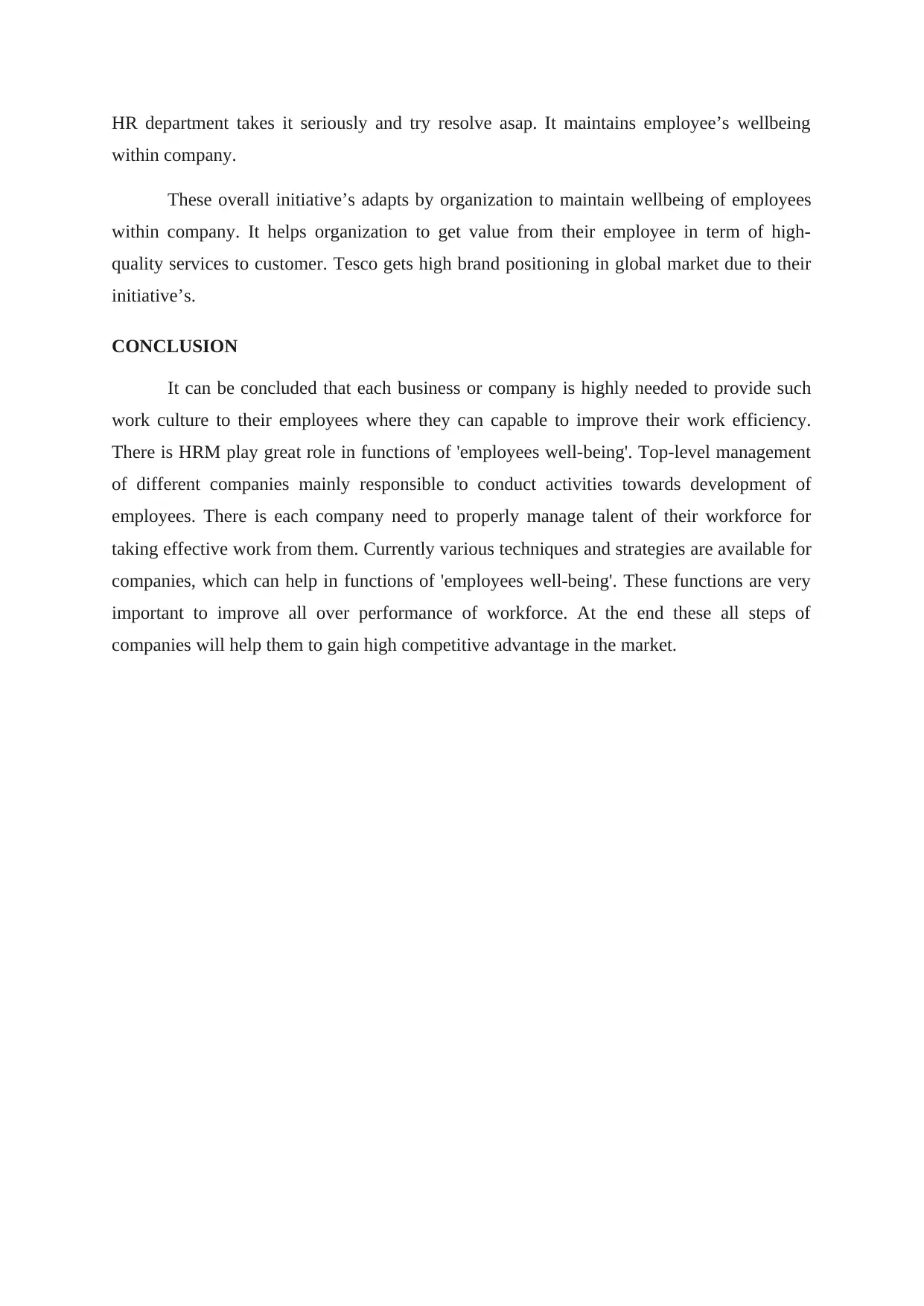
HR department takes it seriously and try resolve asap. It maintains employee’s wellbeing
within company.
These overall initiative’s adapts by organization to maintain wellbeing of employees
within company. It helps organization to get value from their employee in term of high-
quality services to customer. Tesco gets high brand positioning in global market due to their
initiative’s.
CONCLUSION
It can be concluded that each business or company is highly needed to provide such
work culture to their employees where they can capable to improve their work efficiency.
There is HRM play great role in functions of 'employees well-being'. Top-level management
of different companies mainly responsible to conduct activities towards development of
employees. There is each company need to properly manage talent of their workforce for
taking effective work from them. Currently various techniques and strategies are available for
companies, which can help in functions of 'employees well-being'. These functions are very
important to improve all over performance of workforce. At the end these all steps of
companies will help them to gain high competitive advantage in the market.
within company.
These overall initiative’s adapts by organization to maintain wellbeing of employees
within company. It helps organization to get value from their employee in term of high-
quality services to customer. Tesco gets high brand positioning in global market due to their
initiative’s.
CONCLUSION
It can be concluded that each business or company is highly needed to provide such
work culture to their employees where they can capable to improve their work efficiency.
There is HRM play great role in functions of 'employees well-being'. Top-level management
of different companies mainly responsible to conduct activities towards development of
employees. There is each company need to properly manage talent of their workforce for
taking effective work from them. Currently various techniques and strategies are available for
companies, which can help in functions of 'employees well-being'. These functions are very
important to improve all over performance of workforce. At the end these all steps of
companies will help them to gain high competitive advantage in the market.
Paraphrase This Document
Need a fresh take? Get an instant paraphrase of this document with our AI Paraphraser
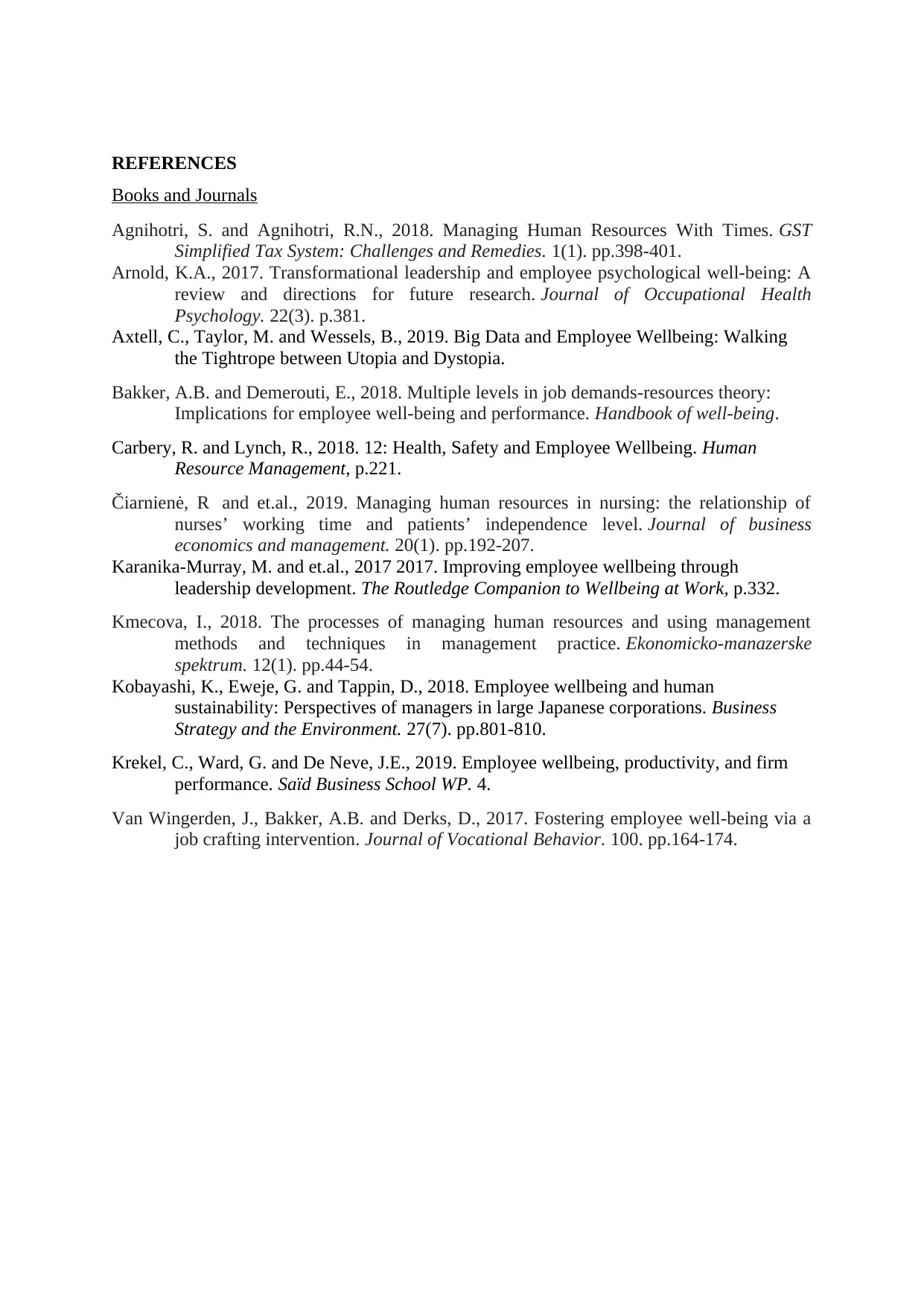
REFERENCES
Books and Journals
Agnihotri, S. and Agnihotri, R.N., 2018. Managing Human Resources With Times. GST
Simplified Tax System: Challenges and Remedies. 1(1). pp.398-401.
Arnold, K.A., 2017. Transformational leadership and employee psychological well-being: A
review and directions for future research. Journal of Occupational Health
Psychology. 22(3). p.381.
Axtell, C., Taylor, M. and Wessels, B., 2019. Big Data and Employee Wellbeing: Walking
the Tightrope between Utopia and Dystopia.
Bakker, A.B. and Demerouti, E., 2018. Multiple levels in job demands-resources theory:
Implications for employee well-being and performance. Handbook of well-being.
Carbery, R. and Lynch, R., 2018. 12: Health, Safety and Employee Wellbeing. Human
Resource Management, p.221.
Čiarnienė, R and et.al., 2019. Managing human resources in nursing: the relationship of
nurses’ working time and patients’ independence level. Journal of business
economics and management. 20(1). pp.192-207.
Karanika-Murray, M. and et.al., 2017 2017. Improving employee wellbeing through
leadership development. The Routledge Companion to Wellbeing at Work, p.332.
Kmecova, I., 2018. The processes of managing human resources and using management
methods and techniques in management practice. Ekonomicko-manazerske
spektrum. 12(1). pp.44-54.
Kobayashi, K., Eweje, G. and Tappin, D., 2018. Employee wellbeing and human
sustainability: Perspectives of managers in large Japanese corporations. Business
Strategy and the Environment. 27(7). pp.801-810.
Krekel, C., Ward, G. and De Neve, J.E., 2019. Employee wellbeing, productivity, and firm
performance. Saïd Business School WP. 4.
Van Wingerden, J., Bakker, A.B. and Derks, D., 2017. Fostering employee well-being via a
job crafting intervention. Journal of Vocational Behavior. 100. pp.164-174.
Books and Journals
Agnihotri, S. and Agnihotri, R.N., 2018. Managing Human Resources With Times. GST
Simplified Tax System: Challenges and Remedies. 1(1). pp.398-401.
Arnold, K.A., 2017. Transformational leadership and employee psychological well-being: A
review and directions for future research. Journal of Occupational Health
Psychology. 22(3). p.381.
Axtell, C., Taylor, M. and Wessels, B., 2019. Big Data and Employee Wellbeing: Walking
the Tightrope between Utopia and Dystopia.
Bakker, A.B. and Demerouti, E., 2018. Multiple levels in job demands-resources theory:
Implications for employee well-being and performance. Handbook of well-being.
Carbery, R. and Lynch, R., 2018. 12: Health, Safety and Employee Wellbeing. Human
Resource Management, p.221.
Čiarnienė, R and et.al., 2019. Managing human resources in nursing: the relationship of
nurses’ working time and patients’ independence level. Journal of business
economics and management. 20(1). pp.192-207.
Karanika-Murray, M. and et.al., 2017 2017. Improving employee wellbeing through
leadership development. The Routledge Companion to Wellbeing at Work, p.332.
Kmecova, I., 2018. The processes of managing human resources and using management
methods and techniques in management practice. Ekonomicko-manazerske
spektrum. 12(1). pp.44-54.
Kobayashi, K., Eweje, G. and Tappin, D., 2018. Employee wellbeing and human
sustainability: Perspectives of managers in large Japanese corporations. Business
Strategy and the Environment. 27(7). pp.801-810.
Krekel, C., Ward, G. and De Neve, J.E., 2019. Employee wellbeing, productivity, and firm
performance. Saïd Business School WP. 4.
Van Wingerden, J., Bakker, A.B. and Derks, D., 2017. Fostering employee well-being via a
job crafting intervention. Journal of Vocational Behavior. 100. pp.164-174.
1 out of 11
Related Documents
Your All-in-One AI-Powered Toolkit for Academic Success.
+13062052269
info@desklib.com
Available 24*7 on WhatsApp / Email
![[object Object]](/_next/static/media/star-bottom.7253800d.svg)
Unlock your academic potential
Copyright © 2020–2025 A2Z Services. All Rights Reserved. Developed and managed by ZUCOL.





